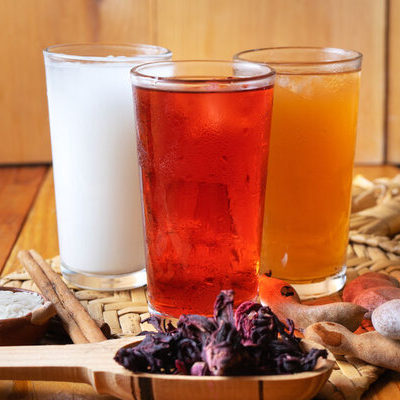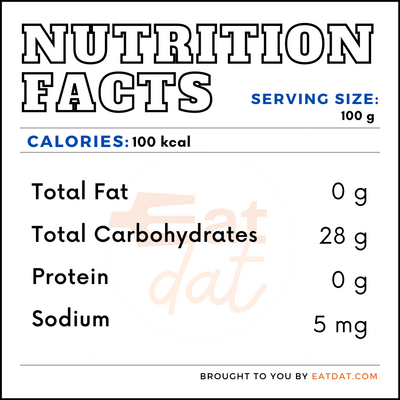
Aguas Frescas
What are Aguas Frescas?
Aguas frescas are light, non-alcoholic beverages made from a mixture of tropical fruits, flowers, cereals, and seeds blended with water and sugar. The name comes from Spanish and means ‘fresh waters’ or ‘cool waters’.
- These beverages are often sold in eateries and bodegas (small shops that sell groceries and wine) throughout Mexico, Central America, and the Caribbean.
- Aguas frescas can also be found in taquerias and Mexican cafés in the United States.
Some of the most popular flavors of aguas frescas include:
- Jamaica
- Horchata
- Tamarindo
Origin of aguas frescas
Mexican lore has it that the Mexica (Aztec) prepared the first aguas frescas from fruits gathered as they paddled along waterways of Tenochtitlá, which is presently the ever-bustling Mexico City. The Mexica added some ice obtained from Iztaccíhuatl and Popocatépetl, dormant volcanoes. Over time, this drink grew to be popular among Mexican and Guatemalan home kitchens and street fare. They boomed considerably in Michoacán, the famous sugarcane state.
By the 1940s, aguas frescas and paletas, their close cousin, migrated to vendors’ carts – along with several sweet and savory treats – in the United States. Soon enough, entire business conglomerates were built only on the infusions of cold fruits. La Michoacana has become one of the most popular and recognizable chains producing this non-alcoholic beverage. Still, the most popular flavors of jamaica (hibiscus tea), horchata, and tamarindo can be enjoyed the world over.
Nutrition
In a 100g serving, there are:

Aguas frescas are always refreshing and hydrating. They are a great way to stay hydrated and cool in summer. However, the tremendous health benefits these non-alcoholic beverages offer make them winners among others. This drink blends whole fruits with no filtering required, meaning all fiber that is present in the fruits is retained. This easily translates to a lower glycemic index – depending on the type of fruit used.
This has a much lower impact on blood sugar levels. Furthermore, aguas frescas are also loaded with many phytochemicals and antioxidants, which help combat any medical condition that requires caution in consumption of some nutrients and minerals. Nonetheless, aguas frescas are sweetened drinks, mostly sweetened with sugar or syrup. Sugar intake can lead to obesity, dental cavities, and other noncontagious diseases. Therefore, one should take care when it comes to the consumption of sugary drinks.
Commercial Production
The general processes involved in producing aguas frescas include:
- Peeling tamarind pods or the skin of any other fruit being used
- Boiling the pods or fruit in water
- Adding sugar to the mixture and blending until liquefaction
- Straining
The global food and beverages market of this drink reportedly reached a value of close to $5.94 billion in 2019. This shows that it increased at a growth rate of 5.7 percent since 2015. This market is presently expected to grow at a CAGR of 6.1 percent from 2019 and reach up to $7.5 billion by 2023, $8.3 billion by 2025, and $11.97 billion by 2030.
Application
Aguas frescas can be made easily at home, when using a high-powered blender. You can also experiment with several fruits like:
- Strawberries
- Pineapple
- Cucumber with fresh mint
- Honeydew lemon
- Cantaloupe
Take care when using blackberries or blueberries, as they may not provide enough sweetness. Also, you may need a fine-mesh sieve to get rid of seeds, which could be a bit cumbersome. This drink is best served fresh over ice. However, if you want to save leftovers, chill the drink in the refrigerator for up to 72 hours. Stir from time to time, as the liquid tends to separate when it sits still for a long time.
Aguas fresca recipes
There are several ways to make this drink. Here are some popular recipes:
- Lime Leaf Agua Fresca
- Kiwi Agua Fresca
- Watermelon Mint Aguas Fresca
- Peach Agua Fresca
- Mango Pineapple Aguas Fresca
FDA Regulation
The Food & Drug Administration has no regulations for this drink. However, the FDA monitors the growing, harvesting and handling of fruits and vegetables which are constituents of this drink. The organization also outlines mandatory rules producers must follow to display nutrition information. Furthermore, the FDA has regulations regarding added sugars and how they can be listed on nutrition labels.
References
“Sugar-Sweetened Beverages Are the Main Sources of Added Sugar Intake in the Mexican Population” https://academic.oup.com/jn/article/146/9/1888S/4584783
Guzmán, Alicia Inez. “The Enduring Appeal of Aguas Frescas.” NewMexico.org, New Mexico Tourism Department, 2 Apr. 2019, www.newmexico.org/nmmagazine/articles/post/matteos-aguas-frescas/
CFR – Code of Federal Regulations Title 21.” Accessdata.fda.gov, U.S Food & Drug Administration, 1 Apr. 2019, https://www.accessdata.fda.gov/scripts/cdrh/cfdocs/cfcfr/CFRSearch.cfm?fr=112.1&SearchTerm=fruits
